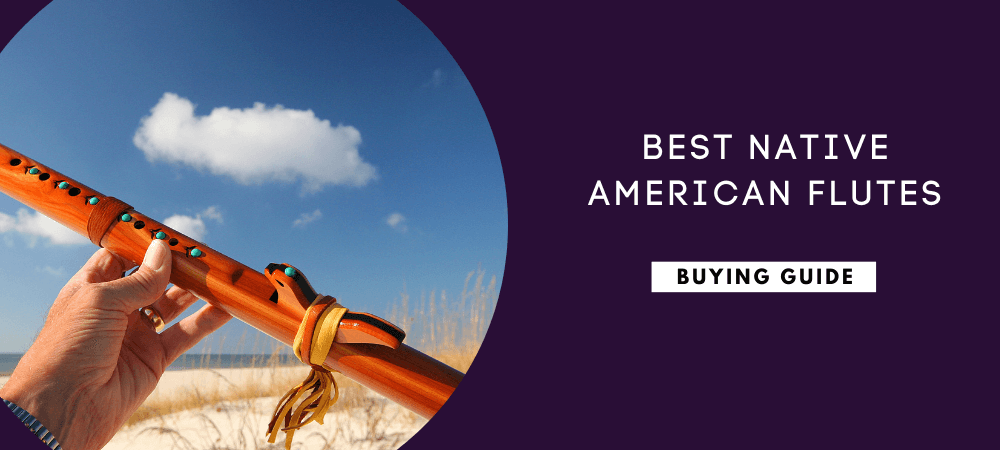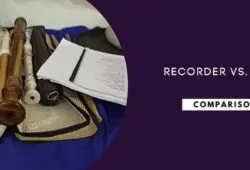Native Americans take great pride in their culture band. This is evident in their lifestyles, regalia, art forms, and beliefs.
To such an extent that, did you know that the name “Native American Flute” is a property right of Native American people?
Well, now, you do.
Legally, a native American flute is one that’s made by an enrolled member of a registered Native American tribe.
Technicalities aside, though, “Native American flute” has now become the accurate musical term for a wooden duct flute with a block whistle mechanism.
Whether you need to get one for meditation, entertainment, dance, religious ceremonies, and rituals or merely as a decorative item, this detailed review is sure to come in handy.
Table of Contents
Best Native American Flutes In 2024 Reviewed
Basic G is actually a popular key for most Native American flutes.
This is because the flute is small enough to be comfortably played by both beginners and experienced players.
The flute measures 23.5” long and has a 7/8” bore.
Finger holes are placed about 1.125” apart while the distance between the mouth end of the flute and the first finger hole is about 10.125”.
Because the key of G is a popular choice, a flutist can play this instrument with other musicians such as guitarists and pianists.
Speaking of performing with other musicians, this Stellar flute comes with concert-quality 440 tunings making it an excellent choice for performances.
The flute is made from high-quality Western Red Cedar – the same wood used to make the resonant belly of guitar and other string instruments.
Cedar is an excellent choice of material, seeing as this wood has impressive acoustical properties and moisture and rot-resistant.
Both the interior and exterior surfaces of this flute have been sealed with 4 coats of waterproof varnish.
The type of Western Red Cedar used in constructing this flute is medium colored, meaning the flutes range in color from red-brown to dark brown.
- Affordably priced.
- Plays incredibly well.
- Extremely lightweight.
- Beautifully finished with adequate lacquer.
- Comes with an instructional booklet.
- Some holes could use a little sanding to smoothen out rough edges.
If you are looking for a beautiful decorative Native American style keepsake flute, then this is it.
This flute is made using jacaranda wood, whose rich grain gives the Quena flute its extraordinary beauty.
Handcrafted using rustic tools, this flute boasts exceptional craftsmanship that’s hard to come by in this era of mass-produced items.
In case you are doubting its authenticity, don’t.
This is an authentic NOVICA artisan handcrafted fair trade product.
The flute measures 15” long and has a 1” bore diameter. It weighs 0.2 lbs.
Although primarily designed as a decorative item, this flute plays remarkably beautiful, carrying on the legacy of the Inca.
The finger holes on this Traditional Peruvian flute are of different widths, which enhances the sweet sound coming from the instrument.
A fingering chart and a carrying case have been included with this flute. The beautiful cloth case emulates pre-Hispanic textiles, so in addition to being functional, it also serves an aesthetic purpose.
- Handcrafted.
- Gorgeous wood and detailing.
- Exceptionally lovely warm sound.
- An Authentic artisan fair trade flute.
- Comes with a beautiful tribal carrying case.
- The large finger holes require some getting used to.
If you’ve been looking for a new accent piece on your home or wish to gift a flute to a friend, you can’t go wrong with this one.
Featuring multiple colors and designs on the surface, you will absolutely love how this Native American flute looks.
The unique art on the flute is 100% hand-painted and hand-carved, so you know that it was made with a lot of love and care.
Besides that, the rustic wood finish beautifully complements the colorful artwork used on the flute.
Crafted using traditional techniques, this flute would be a beautiful decorative piece in your home or office if that’s what you are going for.
Should you choose to get it for playing, then you won’t be disappointed either. The flute sounds pretty good.
This bamboo flute measures 15.5” in length and has a bore diameter of 1”.
- Hand-carved surface.
- 100% hand-painted to perfection.
- Made using traditional techniques.
- Perfect for use as a decorative piece.
- Ideal playability for kids.
- Not tuned to a true musical scale.
One crucial feature is that this Native American flute has been specially designed to suit female players and those with smaller hands.
This essentially means that although this is a lower-key flute, it doesn’t have as long of a finger stretch as some D flutes do.
Tuned to the Key of low D, this Native American flute produces a beautiful deep tone perfect for those who want a flute that’s more meditative in quality.
This is actually a very popular bass flute, and that’s because of its smooth full voice.
Better yet, the flute is hand-tuned, which speaks of its quality and equally impressive performance when played.
The high-quality flute is constructed using Aromatic Red Cedar that has excellent acoustical properties.
Besides that, this flute also has excellent sensitivity and response, meaning the player would require very little air to play.
In addition to being hand-tuned, the flute is handmade as well using impeccable craftsmanship. This flute is 25.5” long.
Being a 6-hole flute, you can cover the 6th hole (3rd hole from the top) using the provided leather ties/bindings. This way, you can use this instrument either as a 6-hole or as a 5-hole flute.
- Handmade and hand-tuned.
- Easy to play despite being a bass flute.
- Concert level professional instrument.
- Beautiful real wood inlays.
- Comes with leather ties.
- None.
How often do you get a high-quality instrument that’s affordably priced? Not often – I’ll tell you that!
It measures 23.5” long and has a 7/8” bore.
The finger holes are spaced roughly 1.125” apart and the distance from the mouth end of the flute to the first finger hole is 10.125”.
This flute’s small nature means that a wide variety of flutists can comfortably play it.
Tuned to the Key of G, this flute plays one pentatonic scale consisting of the notes G, A#, C, D, and F.
It’s a concert-quality flute with 440 tunings, so the flutist will be able to play alongside other musicians such as guitarists and pianists.
Made using Natural Heartwood Cedar, the interior and exterior surfaces of this flute are sealed with 4 coats of waterproof varnish.
You will be glad to know that the instrument is so well lacquered that you will not need to oil it, which conveniently reduces the amount of effort you have to put into maintaining the instrument.
- Well-crafted.
- Affordably priced high-quality instrument.
- Plays incredibly well.
- Suits beginners and experienced players alike.
- Comes with a carrying case.
- Can’t be used as a meditative flute.
Types of Native American Flutes
There are two distinct styles of Native American flutes: Plains Flutes and Woodlands Flutes. There’s no consensus as to what this naming style means.
One school of thought is that the Plains Flute originated from the grasslands, whereas the Woodlands Flute originated from the wooded regions.
Just as well, the differences between these two styles are very subtle and often has to do with the way air is flowing through the bird. Plains Flutes have the air channel cut into the bird, whereas Woodlands Flutes have the airway cut into the flute’s body under the bird.
Generally, these two flute designs are different in how they are shaped, how they create sound, and their fingering holes.
Nonetheless, these are the two styles commonly used to distinguish between Native American flute designs.
1) Plains Flutes
The Plains Flute is the most widely manufactured and recognized Native American flute.
This flute goes by a variety of names, including Courting Flute, Love Flute, Cedar Flute, or Two-Chambered Duct Flute.
This instrument’s superior appeal lies in the fact that it’s easy to play and produces a deeply satisfying sound.
Standard identifying features of a Plains Flute include:
- The flue can be carved either into the flute or in the block.
- A tapered mouthpiece that fits between the lips.
- Holes that are drilled or bored.
- Constructed with a sharp splitting edge on the second soundhole.
- Uses a spacer plate to create the flue.
- Traditionally built from Cedar.
- Uses an external block or wide leather strap to make the whistle.
- Has a “buzzy” reedy timbre.
- Generally, 5-holed.
- The nest area is level or lowered into the flute.
One of the oldest museum-held Plains Flute in existence is estimated to have been constructed sometime between 1800 and 1825. This cedar flute is wrapped in intestine and comes with a spacer and block.
2) Woodlands Flutes
You may also have heard this flute being referred to as the Eastern Woodlands Flute.
The appeal of this instrument lies in the fact that it has a very clear tone and strong sound.
Standard identifying features of a Woodlands Flute are:
- The flue is carved into the body of the flute.
- A blunted mouthpiece that fits against the lips.
- Holes are burned with rods.
- Constructed with a blunted cutting edge on the second soundhole.
- Has a “mellow” timbre.
- Generally, 6-holed.
- The nest area is raised.
- Usually, they have a larger bore diameter, which allows for friendlier hole spacing.
- Typically uses
as fingering for the octave note.
The Woodlands style places the focusing channel in the flute’s barrel, and this, together with the blunt fipple edge, gives a more rounded and warm sound. Unlike the buzzy timbre, you get with a plains flute.
This instrument’s friendlier spacing means that a player with smaller hands would find it easier to play lower keys on a Woodlands Flute.
How to Choose A Native American Flute
A Native American flute has just two chambers: a top mouth chamber and a bottom resonating chamber. An internal wall separates these two chambers.
Depending on which tribe is making the flutes, you will find that there are variations in the flutes’ lengths and the number of holes on the flute’s barrel. A flute may have 2,3,4,5,6,7 or even 8 holes.
Generally, your choice of a flute will be based on the flute’s hand-ability, durability, affordability, and ease of breath control.
Let’s zero in of these factors by assessing various aspects of a flute, i.e.:
Size
When considering the size of the instrument, your decision will be based on how large your hands are, and how you want your music to sound.
A small and narrow flute will result in a high-pitched sound, whereas a longer, wider flute will give off a deeper tone.
Hole Placement
A flutist should be able to cover the flute’s tone holes completely in that there are no air leaks.
This means that the most essential comfort factor on a Native American flute is the distance between the finger holes on the flute’s barrel.
Most flute makers try to ensure that the finger holes on their flutes are set an inch apart, at least for flutes up to F#4.
The general rule here would be if you’ve never played a Native American flute before, don’t buy anything larger than F#.
Key of The Flute
Modern Native American flutes are all tuned to a specific pentatonic minor key, and one can only play notes in that key.
A flute’s key is determined by the size of the flute and the hole placement on the flute’s barrel.
On a lower keyed flute, if the Chromatic notes (cross-fingered notes) are to be of equal volume and in tune, then the tone holes should be located farther apart.
As such, the lower the key of the flute, the farther apart the finger holes will be. This is especially true for the ring and index fingers on the right hand, used to cover the holes at the bottom of the Plains Flute.
A, G, and F# (F-sharp) are often regarded as comfortable keys for first-time flutists. On these flutes, the player’s fingers naturally cover the holes without having to stretch into awkward positions.
However, you might notice that on an F# flute, the ring finger has a slightly greater reach than on a G flute. Therefore, F flutes are generally better suited for players with larger hands.
D and C flutes require quite a bit of breath control and finger flexibility, which means that these flute keys are best suited for more experienced players.
Besides A, G, F#, D, and C, you can also find flutes in other keys such as G#, E, F, and low C.
Single Flutes Vs. Drone Flutes
Single flutes look just like what you’d expect a flute to look like.
Drone flutes are also known as dual-chambered flutes.
These flutes will play a drone through the left chamber and a melody through the right chamber. There’s only one set of finger holes, though, so what happens is that the drone chamber echoes/reverberates the melodic chamber.
A drone flute gives off a much richer sound that may even sound like two flutes are being played.
Key Range
Mid-Octave (alto/tenor) Flutes are melodious and have a warm tone. These flutes are in the Keys of A (above middle C) through E (below middle C)
High-Octave (treble) Flutes have a faster vibration rate and a higher tone. This makes these flutes sound lively and energetically simulating, thereby rendering them perfect for dance.
Low-Octave (bass) Flutes have a lower rate of vibration and, consequently, a lower tone. These flutes give off a resonant and deep sound that slows you down and puts you in a relaxed, meditative mood.
A lower keyed flute is bigger and heavier, which makes it more challenging to hold and play. Also, the tone holes are farther apart.
Material
The wood used to make the flute will affect its sound and weight.
Hardwood (e.g., Walnut) Flutes are heavier and produce a cold bright tone and clear sound.
Softwood (e.g., Pine, Spruce, and Cedar) Flutes are lighter in weight, and they produce a warm, soft sound that’s rich and resonant.
For this reason, you may find that an Aromatic Cedar F# sounds different from a walnut F#.
Pine and Cedar flutes are very popular in the southwest.
Aesthetics
Native American flutes are known for their exceptional craftsmanship and beauty, so it doesn’t hurt to get an instrument that you find visually appealing.
Besides, this way, you can better express your personality, not only musically but also visually, based on the type of flute you are playing.
Some flutes may even come with beads and feathers, to further enhance their appearance and give it that authentic look and feel.
How to Make A Native American Flute
Tip #1: Sourcing the Wood
Choose your wood based on availability, feel, workability, moisture and rot resistance, and the desired sound you wish to get from the instrument.
While softwoods give a mellow sound, hardwoods create sharper tones.
Bamboo is a popular choice for many people because it is readily available and is also hollow, so you won’t struggle to create the inner chambers of the flute. Also, the divisions on a bamboo stem make it easier for you to learn about ratios (inner bore diameter in proportion to the length of the flute).
The following video shows how easily you can go about making a bamboo flute using just a hacksaw and a pocket knife!
If you want a true wooden flute and not one made from bamboo, you can use either branches or lumber.
Tip #2: Gather Your Tools
Now, making a flute using other woods won’t merely involve a hacksaw, and a pocketknife, as the video above illustrates.
You would need a workbench, and more sophisticated tools, including gun drills, routers, lathes, sanding machines, etc.
If you are willing to spend money on these machines, you may go on ahead and buy them. Alternatively, you may also opt to rent them, seeing as some tools can be quite expensive.
One thing to note is that, in many cases, you do not need power tools to build a flute. Everything can be done using gouges, knives, wood files, chisels, and other standard non-power hand tools.
However, as the video below illustrates, using power tools can conveniently make your flute-making process that much easier and faster.
Tip #3: Use Precise Measurements
To get the right sound out of the flute, you would need to use precise measurements.
This is because constructing a functioning flute basically involves understanding the fundamentals of the sound mechanism and the ratios involved.
More about this is discussed below:
How to Play A Native American Flute for Beginners
FAQs About The Best Native American Flutes
What Materials Are Native American Flutes Often Made Of?
Traditionally, Native American flutes could be made from bone, bamboo, clay, river cane, and different woods.
Modern Native American style flutes may be constructed using hardwoods (e.g., Walnut), softwoods (e.g., Cedar), bamboo, or plastic. You may also come across a ceramic or glass flute every once in a while.
What Key Is A Native American Flute In?
The key of a flute is the lowest note (fundamental note) that flute can play, and Native American style flutes come in different keys.
Flutes in the key of A, G, or F# are comfortably sized, making them suitable for novice players.
Lower-toned flutes in the key of F, E, D, or C are longer, making them better suited for more experienced flutists.
Why Does My Native American Flute Squeak?
There are essentially only two possible explanations behind a squeaky flute:
- Not covering the holes completely.
- Blowing way too hard, thereby making the flute jump up in pitch.
Conclusion
The humble Native American flute has survived many generations. And why wouldn’t it?
The instrument produces a beautiful sound enjoyed by many music enthusiasts and excellent musicians alike.
A Native American flute is more than a mere musical instrument. It is an emblem – an art piece that holds great cultural and aesthetic significance.
Picking one up and playing it just might prove to be one of the most transcendental moments of your entire life.
Also, check our top picks for the best professional flutes and also our top recommended flutes for intermediate players.







![Best Native American Flutes In [year]: A Detailed Review 2](https://musictechhub.com/wp-content/uploads/2020/07/1.e-e1595594769948.jpg)


